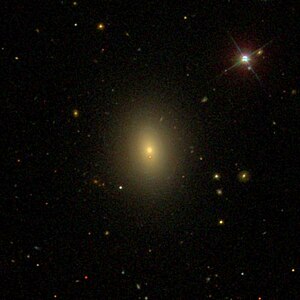NGC 4191
| Galaxy NGC 4191 |
|
|---|---|

|
|
| SDSS recording | |
| AladinLite | |
| Constellation | Virgin |
|
Position equinox : J2000.0 , epoch : J2000.0 |
|
| Right ascension | 12 h 13 m 50.4 s |
| declination | + 07 ° 12 ′ 03 ″ |
| Appearance | |
| Morphological type | S0 / LINER |
| Brightness (visual) | 12.8 mag |
| Brightness (B-band) | 13.8 mag |
| Angular expansion | 1.2 '× 0.8' |
| Position angle | 5 ° |
| Surface brightness | 12.6 mag / arcmin² |
| Physical data | |
| Affiliation | LGG 281 |
| Redshift | 0.008826 ± 0.000017 |
| Radial velocity | 2646 ± 5 km / s |
|
Stroke distance v rad / H 0 |
(115 ± 8) x 10 6 ly (35.2 ± 2.5) Mpc |
| history | |
| discovery | John Herschel |
| Discovery date | April 19, 1830 |
| Catalog names | |
| NGC 4191 • UGC 7233 • PGC 39034 • CGCG 041-049 • MCG + 01-31-026 • 2MASX J12135037 + 0712030 • VCC 94 • GALEX ASC J121350.39 + 071205.5 • LDCE 904 NED014 • EVCC 190 | |
NGC 4191 is a lenticular galaxy with an active nucleus of the Hubble type S0 in the constellation Virgo on the ecliptic . It is estimated to be 115 million light-years from the Milky Way and about 40,000 light-years across . Under the catalog name VCC 94 , it is considered a member of the Virgo galaxy cluster , but is too far away for that.
In the same area of the sky are u. a. the galaxies NGC 4180 , NGC 4224 , NGC 4233 , NGC 4235 .
The object was discovered by John Herschel on April 19, 1830 .
